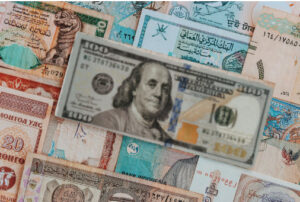
Roosevelt’s gold grab effectively increased the money supply and “legitimized” the inflation that had silently been occurring behind the scenes as prices increased but gold values did not. In the years from 1913 through 1930, inflation had increased 68.69%, so the increase in the price of gold was simply making up for all the hidden inflation.
The Bretton Woods Agreement
For his next trick, at the tail end of WWII, Roosevelt got 44 allied countries together in Bretton Woods, New Hampshire, and squeezed out an agreement making the U.S. dollar the new currency standard. Making the U.S. dollar “as good as gold” was not an easy sell. Both France and Brittan bitterly objected, but Roosevelt did some arm-twisting, enabling the dollar to gain that distinguished stature due to its backing by gold (and the fact that the U.S. had a lot of clout because the rest of the signatories to the agreement owed the U.S a lot of money due to the war at the time.)
27 Years of Inflation
Of course, the U.S. continued to quietly increase its money supply, and eventually, gold was more valuable than the official price again. So, France called our bluff and decided to buy as much gold as they could at a discounted price. With gold reserves fleeing the country, Nixon was forced to unilaterally cancel the convertibility of dollars to gold at Roosevelt’s fixed rate, and the price of gold began to float against the dollar, thus reneging on the deal Roosevelt had made.
The lack of convertibility to gold and high inflation rates resulted in a lack of trust and a declining demand for U.S. dollars on the world market, and a falling exchange rate. In an effort to shore up demand for the dollar, in 1973 Nixon and Kissinger struck a deal with Saudi Arabia. The Saudis agreed that they would denominate all their oil sales in U.S. dollars (i.e. only accept Dollars in payment, no Pounds, Francs, Rubles, etc.), and in exchange, the U.S. would supply weapons and protection to the Saudis. This system of requiring oil sales to be performed in dollars increased the demand for dollars (since everyone needs oil) and became known as the “Petrodollar”. These petrodollars not only increased demand for the U.S dollar but also allowed the U.S. to export its inflation as these dollars never return to the U.S. but instead are used strictly for foreign trade.
By 1975, all of OPEC had agreed to denominate all oil sales in Dollars in exchange for weapons and military assistance.
Fast Forward
In “How Does a Country Export its Inflation?” we looked at how these Petrodollars helped the U.S. retain its dominant position as the world’s reserve currency and how that allowed the U.S. to “export its inflation”. Of course, many major countries were not happy with having to get U.S. dollars in order to be able to purchase their oil needs. They would prefer to use their own currency (and be able to inflate it themselves). So over the years, Russia, China, Latin America, and Muslim countries have hatched various schemes to enable oil trade to occur in currencies other than the U.S. dollar. So far, none have been terribly successful But…
According to a recent Bloomberg article, “Another Gulf State Mulls Dollar Alternatives,” Iraq is the most recent country to attempt to break free of U.S. Dollar hegemony. According to Bloomberg, “Baghdad says it plans to pay for private sector imports from China in yuan in order to inject foreign currency into the financial system and help ease pressure on the dinar.”
Other, countries that are exploring trade deals outside the U.S. dollar are the UAE and India, exploring a deal in Rupees, and even Saudi Arabia is looking into alternatives. So far, these deals have been for non-oil transactions, but cracks are appearing.
In “Is The U.S. Dollar Hegemony Ending?” we saw …
“There are several organizations that are cooperating to develop an alternative to the dollar for the settlement of international trade. The BRICS (Brazil, Russia, India, China, and South Africa), the Shanghai Cooperation Organisation (SCO), and the Eurasian Economic Union have formed a working group to develop a commodity-based medium of exchange to replace the dollar as the premier means for the settlement of international trade.”
Signs of the End of the PetroDollar began emerging quite some time ago. We published So Long, US Dollar As World’s Reserve Currency back in 2012 and Death of the Petrodollar in 2014, but these things always take longer than expected.
Read More:
- Is The U.S. A Powerful “Empire” In Decline?
- America & Money: Cool Facts About the History of Our Monetary System
- Oil, PetroDollars, and Gold
- More on the PetroDollar
- How Does a Country Export its Inflation?
- How Nixon’s Revolutionary Move Influenced U.S. Inflation For 50 Years
- Oil vs Gold
